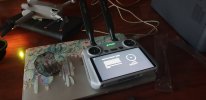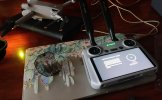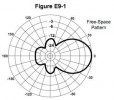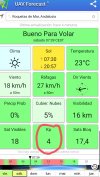Be sure to get the "reverse" RP-SMA not a regular one. Like this: Amazon.com : RP-SMA Male Termination Dummy Loads 1W 3.0GHz 50 ohm RF Coaxial Adapter (Pack of 2) : ElectronicsThey sell antenna terminators that can be screwed on just for that purpose, while the antenna are removed for transport. Just in case you forget. Get a pair!

SMA Dummy Load - www.readymaderc.com
The best quality First Person View equipment. Free or discounted shipping on all orders.Drone Racing, RC Airplanes, FPV Cameras, FPV Goggles, Video Transmitters, RC Quads, Drone Antennas, Lipo Batteries, and Ground Station Equipment.All available for amateurs, schools, hobbyists, government, and...www.readymaderc.com
You are using an out of date browser. It may not display this or other websites correctly.
You should upgrade or use an alternative browser.
You should upgrade or use an alternative browser.
DJI RC External Antennas
- Thread starter finkmj53
- Start date
BroomRider
Well-Known Member
I have a related question re: the Auto band selection, & the Auto vs Manual selection within the 2 band selections.
I've been doing some reading &...
It appears that once the Auto band selection on the RC controller is chosen, the band is automatically selected for the 1 with the least interference, & from there, the communications is locked into either the 2.4gHz or 5.8gHz band, & further selecting the Auto function from there, the different frequencies within each perspective band are automatically switched during flight to (theoretically, at least) choose the frequency with the least interference within the respective band.
Switching between the 2.4 & the 5.8 bands does not appear to automatically occur while flying, which was my original belief.
So, my question is, looking in the menu section, within each band, I see a fluctuating chart showing the varying interference levels across the band, whether it's the 2.4gHz or 5.8gHz.
Are those frequency interference levels measured at the RC controller, the drone, or averaged between the 2?
For instance, whichever frequency band is chosen, if they're liable to change at the location of the drone wherever it is flying, if the drone experiences less interference from its location away from the RC controller, does that automatic frequency selection take that into account & send that via telemetry back to the RC controller, or is the only interference level considered from the location of the RC controller itself?
I'll be doing some tests at my usual location at the beach, & when I encounter weak or lost signal, I'll try switching between bands manually, to try to see if that makes any difference. I also read that there was an issue where the Auto band selection might be faulty in that it didn't necessarily choose the band with the least interference.
I know that all else being equal, the lower frequency band will have the better range, but that also crucially depends on the amount of other traffic interference in that band.
If my understanding is in error, I welcome any insights; I tried to find some clarification online, but it's probably a bit too detailed &/ specific & couldn't find any.
I've been doing some reading &...
It appears that once the Auto band selection on the RC controller is chosen, the band is automatically selected for the 1 with the least interference, & from there, the communications is locked into either the 2.4gHz or 5.8gHz band, & further selecting the Auto function from there, the different frequencies within each perspective band are automatically switched during flight to (theoretically, at least) choose the frequency with the least interference within the respective band.
Switching between the 2.4 & the 5.8 bands does not appear to automatically occur while flying, which was my original belief.
So, my question is, looking in the menu section, within each band, I see a fluctuating chart showing the varying interference levels across the band, whether it's the 2.4gHz or 5.8gHz.
Are those frequency interference levels measured at the RC controller, the drone, or averaged between the 2?
For instance, whichever frequency band is chosen, if they're liable to change at the location of the drone wherever it is flying, if the drone experiences less interference from its location away from the RC controller, does that automatic frequency selection take that into account & send that via telemetry back to the RC controller, or is the only interference level considered from the location of the RC controller itself?
I'll be doing some tests at my usual location at the beach, & when I encounter weak or lost signal, I'll try switching between bands manually, to try to see if that makes any difference. I also read that there was an issue where the Auto band selection might be faulty in that it didn't necessarily choose the band with the least interference.
I know that all else being equal, the lower frequency band will have the better range, but that also crucially depends on the amount of other traffic interference in that band.
If my understanding is in error, I welcome any insights; I tried to find some clarification online, but it's probably a bit too detailed &/ specific & couldn't find any.
pescobar61
Well-Known Member
Many thanks for your wise explanation. Something about this here.
Today I can't trying my new antennae because the bad weather (dry storms)...maybe tomorrow morning.

But the strong winds and now the high KP radiation don't give me a chance for trying the new antennae...
BroomRider
Well-Known Member
High KP radiation? Wuzzat?View attachment 153443
But the strong winds and now the high KP radiation don't give me a chance for trying the new antennae...
pescobar61
Well-Known Member
pescobar61
Well-Known Member
This morning I was trying the Mini 3 Pro' RC with new antennae. I don't need the longest range but a strong and stable signal and I have it now with external DX - Link antenna. More 3 km with any RTH. I don't try the directional Alfa APA-M25 because for me is sufficient with the DXs. Any image lag too.


Congrats on the bravery to drill holes in your brand new controller.This morning I was trying the Mini 3 Pro' RC with new antennae. I don't need the longest range but a strong and stable signal and I have it now with external DX - Link antenna. More 3 km with any RTH. I don't try the directional Alfa APA-M25 because for me is sufficient with the DXs. Any image lag too.
View attachment 153849
"I don't need the longest range but a strong and stable signal and I have it now"
That's really it. In the wrong direction from my home, I was seeing a laggy, jumpy screen as near as a couple hundred yards. Now it's great.
I love to tinker with things. I am going to do the mod just to see the difference. One location I frequently fly in is an urban area in San Antonio and I lose signal after about 1/2 mile. It is spotty along the route as well. I am curious to see if this will help with the signal in this.
This is not a major thing to do. No soldering. Just take apart the case, and plug in two new antenna's. Save the original and put back in if you want. Yada yada..ya got to drill two holes in the case................or do you!
I am going to file two very small cutouts (wide enough for the RG-178 cable to fit. I am going to 3D print a bracket that screws into the back or bottom holes of the controller to which the SMA ends will be attached to. I should be able to keep the original antennas still in the controller doing it this way.
Remember guys: not everyone is doing this as a profession or for cinema photography. I made my first RC plane back in 1976 from scratch. Throughout my life, I have re-engineered things. Getting an existing product and experimenting with it is a fun thing to do.
And when people experiment, the parent company notices and helps them improve their own products.
I am thinking about making a switch so I can switch between the original antennas and the new ones.
This is not a major thing to do. No soldering. Just take apart the case, and plug in two new antenna's. Save the original and put back in if you want. Yada yada..ya got to drill two holes in the case................or do you!
I am going to file two very small cutouts (wide enough for the RG-178 cable to fit. I am going to 3D print a bracket that screws into the back or bottom holes of the controller to which the SMA ends will be attached to. I should be able to keep the original antennas still in the controller doing it this way.
Remember guys: not everyone is doing this as a profession or for cinema photography. I made my first RC plane back in 1976 from scratch. Throughout my life, I have re-engineered things. Getting an existing product and experimenting with it is a fun thing to do.
And when people experiment, the parent company notices and helps them improve their own products.
I am thinking about making a switch so I can switch between the original antennas and the new ones.
Assuming you haven't cut yet, look under the rubber holder for the sticks. There is a hole with plenty of room for the coax. Since the rubber is soft, it is possible you could fit the holder back in with the cables in place. In any case, you can test with no cutting. To (theoretically) minimize loss, I used a thicker shorter cable that likely wouldn't have fit well.I love to tinker with things. I am going to do the mod just to see the difference. One location I frequently fly in is an urban area in San Antonio and I lose signal after about 1/2 mile. It is spotty along the route as well. I am curious to see if this will help with the signal in this.
This is not a major thing to do. No soldering. Just take apart the case, and plug in two new antenna's. Save the original and put back in if you want. Yada yada..ya got to drill two holes in the case................or do you!
I am going to file two very small cutouts (wide enough for the RG-178 cable to fit. I am going to 3D print a bracket that screws into the back or bottom holes of the controller to which the SMA ends will be attached to. I should be able to keep the original antennas still in the controller doing it this way.
Remember guys: not everyone is doing this as a profession or for cinema photography. I made my first RC plane back in 1976 from scratch. Throughout my life, I have re-engineered things. Getting an existing product and experimenting with it is a fun thing to do.
And when people experiment, the parent company notices and helps them improve their own products.
I am thinking about making a switch so I can switch between the original antennas and the new ones.
Share a picture of the mod; which exact antenna you used; and the results when you are done if you have a moment.
Good luck!
Thanks. I have not opened it yet. I will look for any existing ways of getting the cable through without any physical alterations. I have made rf switches before. I am looking to design a simple one to switch from one set to the other set.Assuming you haven't cut yet, look under the rubber holder for the sticks. There is a hole with plenty of room for the coax. Since the rubber is soft, it is possible you could fit the holder back in with the cables in place. In any case, you can test with no cutting. To (theoretically) minimize loss, I used a thicker shorter cable that likely wouldn't have fit well.
Share a picture of the mod; which exact antenna you used; and the results when you are done if you have a moment.
Good luck!
BroomRider
Well-Known Member
I have watched a couple of M3P disassembly videos, & have read conflicting reports as to where the antennas are for that drone.
Some I read, say they are in the front motor arms, & others say they are in the back, yet in both disassemblies I have watched, both the front & rear wires to the motors are the same 3 colored wires, with no other visible wires that might be the antennas; the exception in the front arms are the 2 small wires that feed the LEDS under the front motors, or that's what I'm gathering they are for.
Regardless whether the antennas are in the front or rear, wouldn't it be possible to duplicate, with little added complexity or weight, a 2nd pair of antennas, & place them in the other 2 arms?
I'm thinking, all this discussion about improving the antennas in the controller, yet the antennas on the drone must be equally important to upgrade if possible & surely result in better communication.
Any upgrades to the controller antennas would be that much more effective, if needed at all.
Anyone's thoughts?
Some I read, say they are in the front motor arms, & others say they are in the back, yet in both disassemblies I have watched, both the front & rear wires to the motors are the same 3 colored wires, with no other visible wires that might be the antennas; the exception in the front arms are the 2 small wires that feed the LEDS under the front motors, or that's what I'm gathering they are for.
Regardless whether the antennas are in the front or rear, wouldn't it be possible to duplicate, with little added complexity or weight, a 2nd pair of antennas, & place them in the other 2 arms?
I'm thinking, all this discussion about improving the antennas in the controller, yet the antennas on the drone must be equally important to upgrade if possible & surely result in better communication.
Any upgrades to the controller antennas would be that much more effective, if needed at all.
Anyone's thoughts?
@BroomRider: I think they are in the rear to tell ya the truth. Just by observation. I am not tearing apart my drone to figure it out though LOL..I do have an RF meter so I will see if I can see a difference and map out the RF propagation (which would be nice if DJI did that for us so we know! I am a Ham Radio operator so knowing about RF propagation s very important!
I just did a quick mod on my RC Controller. I use to be able to do 2300 ft at 200 agl in an urban environment.
After the mod I did 3800 ft. Same time of day, same flight profile, You guys do the math..but that is drastic.
I am not a DJI fanboy, nor am I not. DJI makes a spec assuming everything is PERFECT. I would assume that is true. Many fly in areas where foliage, buildings, and other obstructions affect things. Just telling you that 15 bucks and 30 minutes make a big difference for me.
DJI makes a spec assuming everything is PERFECT. I would assume that is true. Many fly in areas where foliage, buildings, and other obstructions affect things. Just telling you that 15 bucks and 30 minutes make a big difference for me.
I never removed the original antennas. It would take 5 minutes to plug them back in. I am designing an rf switch that will switch between the two.
The only thing you can see as far as physical changes to the remote are two small (1.5mm) holes to allow the cable to pass through. I used painter's tape (LOL) to tape the antennas to the side of the controller for the test. I am going to fabricate a 3D-printed mount. I would actually think that doing that it would increase the range as well since the antenna will be separated by about 2 inches from the RC and my body.
Your miles may vary and have a good comfort level tearing into things!
After the mod I did 3800 ft. Same time of day, same flight profile, You guys do the math..but that is drastic.
I am not a DJI fanboy, nor am I not.
I never removed the original antennas. It would take 5 minutes to plug them back in. I am designing an rf switch that will switch between the two.
The only thing you can see as far as physical changes to the remote are two small (1.5mm) holes to allow the cable to pass through. I used painter's tape (LOL) to tape the antennas to the side of the controller for the test. I am going to fabricate a 3D-printed mount. I would actually think that doing that it would increase the range as well since the antenna will be separated by about 2 inches from the RC and my body.
Your miles may vary and have a good comfort level tearing into things!
Last edited:
In this video, you can see the coax for the rear antenna at about 15:24 and the front antenna cable at 16:19 (the longest one.) It's blurry but you can follow the gold coax connectors:I have watched a couple of M3P disassembly videos, & have read conflicting reports as to where the antennas are for that drone.
Some I read, say they are in the front motor arms, & others say they are in the back, yet in both disassemblies I have watched, both the front & rear wires to the motors are the same 3 colored wires, with no other visible wires that might be the antennas; the exception in the front arms are the 2 small wires that feed the LEDS under the front motors, or that's what I'm gathering they are for.
Regardless whether the antennas are in the front or rear, wouldn't it be possible to duplicate, with little added complexity or weight, a 2nd pair of antennas, & place them in the other 2 arms?
I'm thinking, all this discussion about improving the antennas in the controller, yet the antennas on the drone must be equally important to upgrade if possible & surely result in better communication.
Any upgrades to the controller antennas would be that much more effective, if needed at all.
Anyone's thoughts?
The clearer iFixIt video did not remove the arms. But this is too much surgery for me. I don't mind losing the warranty on the controller (if there even is one) but de-soldering the EMC is sure to violate everything if it wasn't already after removing the UV glue from the screws.
But if you do it, I would love to see the result.
BroomRider
Well-Known Member
I did go back & click&stop so I could get as much of a frame-by-frame as possible... & it does appear you're correct & it is a shame that a more clear resolution isn't available in this video.In this video, you can see the coax for the rear antenna at about 15:24 and the front antenna cable at 16:19 (the longest one.) It's blurry but you can follow the gold coax connectors:
The clearer iFixIt video did not remove the arms. But this is too much surgery for me. I don't mind losing the warranty on the controller (if there even is one) but de-soldering the EMC is sure to violate everything if it wasn't already after removing the UV glue from the screws.
But if you do it, I would love to see the result.
So then, the M3P does appear to have antennas in each leg, (4) - those thin & longer white wires - not 2, as most seem to claim.
That resolves that question for me re: increasing antenna area in the M3P.
The only reason now that I'd be inclined to take apart the drone, after the warranty was up ofc, would be to increasing its resistance to moisture & rain by applying a conformal (brushed) silicone sealant & an anti-corrosive contact protectant to electrical connections/plugs, etc. designed for the purpose.
Ofc, that is a topic for another thread...
pescobar61
Well-Known Member
Go ahead! I made it at my Mavic Mini using Kafuter K-705. An easy and cheap alternative to electronic corrosion.The only reason now that I'd be inclined to take apart the drone, after the warranty was up ofc, would be to increasing its resistance to moisture & rain by applying a conformal (brushed) silicone sealant & an anti-corrosive contact protectant to electrical connections/plugs, etc. designed for the purpose.

Sky One Ohio
Member
Thanks, Im modding mine and didn't know about these!They sell antenna terminators that can be screwed on just for that purpose, while the antenna are removed for transport. Just in case you forget. Get a pair!

SMA Dummy Load - www.readymaderc.com
The best quality First Person View equipment. Free or discounted shipping on all orders.Drone Racing, RC Airplanes, FPV Cameras, FPV Goggles, Video Transmitters, RC Quads, Drone Antennas, Lipo Batteries, and Ground Station Equipment.All available for amateurs, schools, hobbyists, government, and...www.readymaderc.com
Here's the thing as a prior electronic engineer and RF tech - without data it's absolutely postively certain to be snakeoil.I saw the same YouTube video. Nowhere did they give a before and after comparison. I wouldn’t be ripping into my RC without having some solid results. BTW, those antennas do work ok on computers for wifi with good results…would just like to see some meaty results on the RC.

Anyone designing antennae without the means to perform empirical tests and provide data with charts is simply guessing at best and bs'ing at worst.
Back when those amplified signal boosters were popular I asked each and everyone of them for a simple azimuth antenna radiation pattern chart. This simply measures the field strength in 360 degrees and provides much useful information. Measurement of antenna gain and VSWR are also helpful to ensure it actually does something and won't kill your transceiver.
But no. One guy actually told me they were confident it works because the customers say so!

That's simply not true. Thinking about your Wi-Fi should show you the error of that statement unless your home has no walls.No RC antenna or antenna mod can penetrate solid objects at any range. You still need clear LOS. What physical objects were between you and your neighbor’s yard, at or below 150’ that blocked the LOS signal of the RC getting to the drone?
Trees are a major source of interference - not because of their size, but because they are mostly water.
Unfortunately 2.4Ghz is pretty close to the resonant frequency of water which means they soak up the signal like an RF sponge. 5.8Ghz is double 2.4 so it also will have the problem.
Having used all the various drone RC antenna mods myself, I stand by my statement, as it pertains to RC antenna mods. The RC antenna mods are not designed to penetrate solid objects nor dense trees, and are not intended for close range, unlike home wifi. All large solid objects and large trees with heavy foliage that visually block for the LOS for more than 5 seconds will cause loss of signal. At least we agree that obstructing trees are problematic.That's simply not true. Thinking about your Wi-Fi should show you the error of that statement unless your home has no walls.
Trees are a major source of interference - not because of their size, but because they are mostly water.
Unfortunately 2.4Ghz is pretty close to the resonant frequency of water which means they soak up the signal like an RF sponge. 5.8Ghz is double 2.4 so it also will have the problem.
My question was also never answered by the person I asked it of, which would have proven my premise. Always maintain a clear LOS for best signal, with and without antenna mods.
Similar threads
- Replies
- 8
- Views
- 928
- Replies
- 12
- Views
- 4K
- Replies
- 11
- Views
- 8K
DJI Drone Deals
New Threads
-
-
-
-
Selling Mini 4 Pro Fly More Combo, RC2 controller, 3 batteries, 8 ND Filters
- Started by Dale D
- Replies: 0
-
Members online
Total: 2,661 (members: 13, guests: 2,648)











